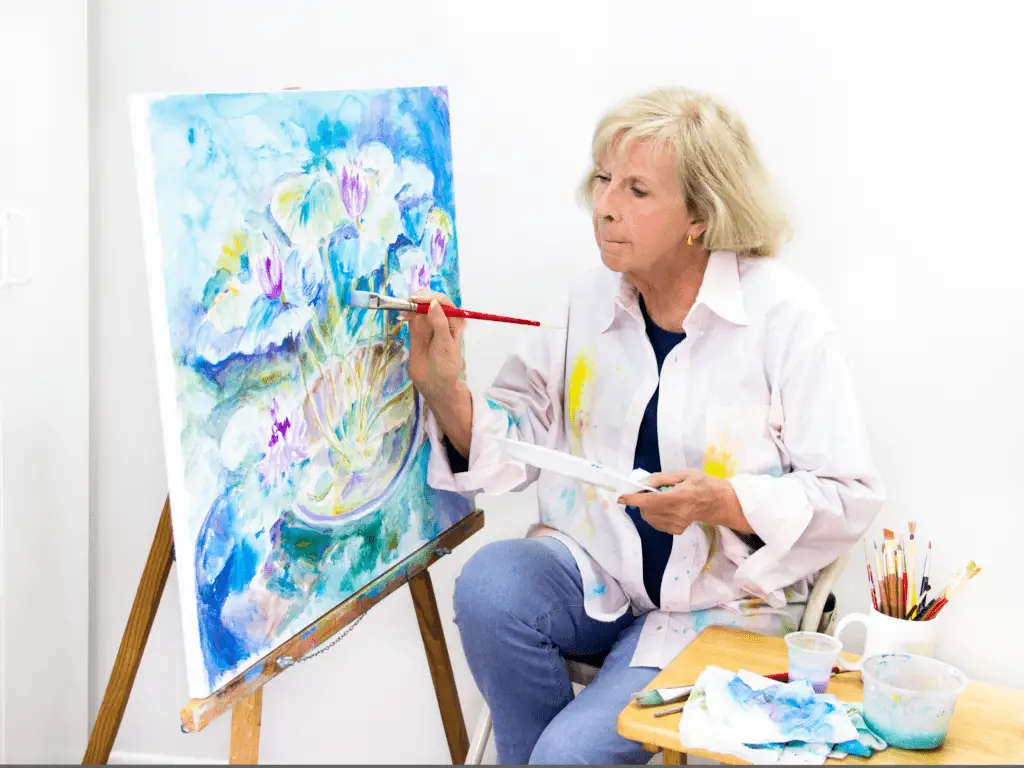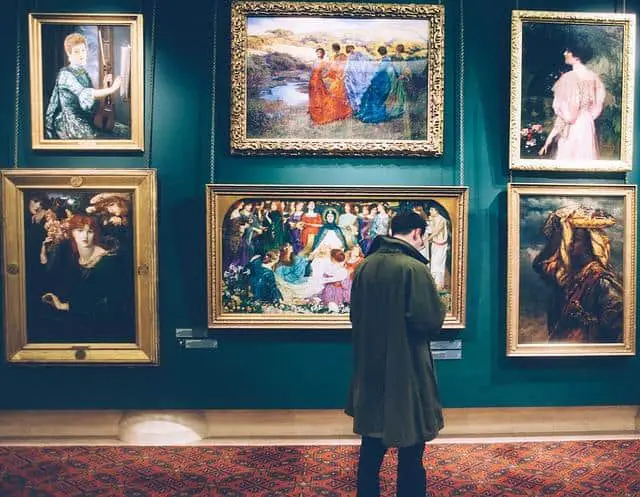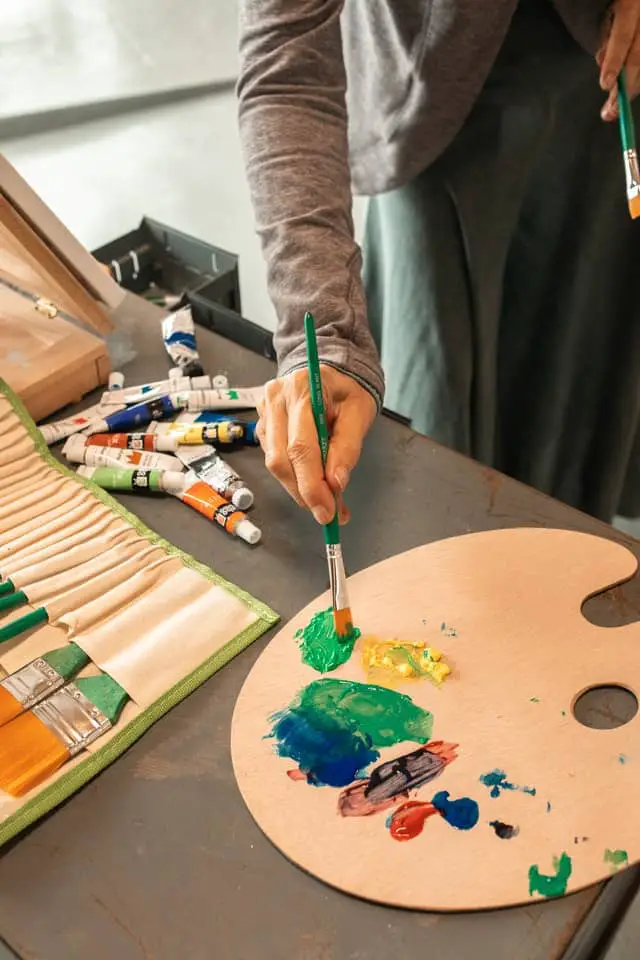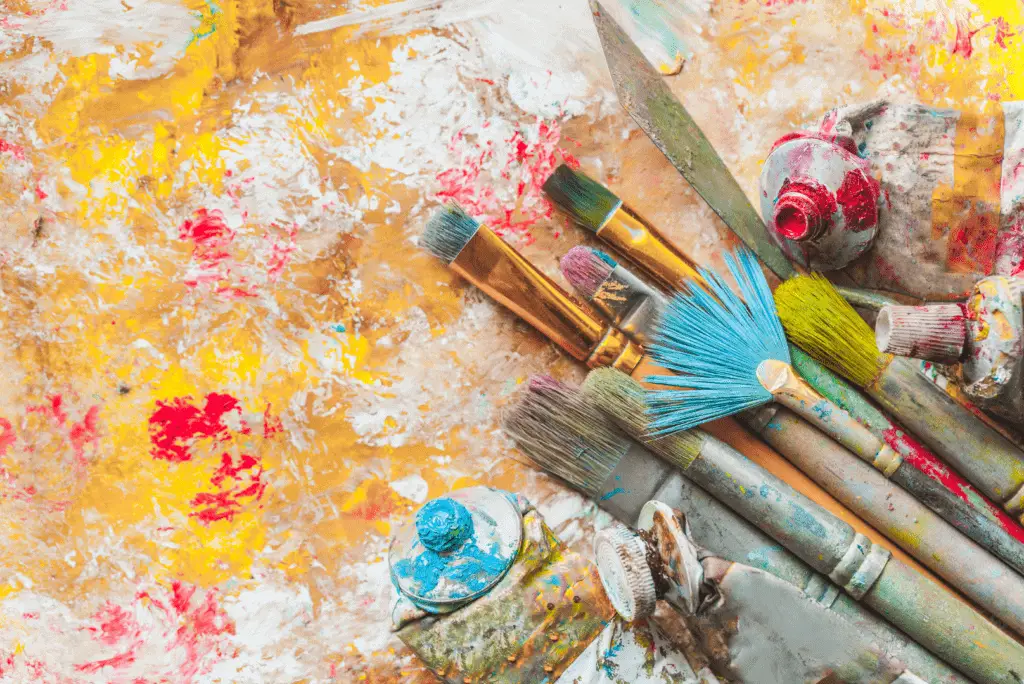Acrylic paint is one of the greatest inventions of art history. As with almost everything, acrylic paint also has its pros and cons. All pros and cons of acrylic paint depending on the artist. One may see some aspect as a pro while another artist can see the same thing as a con.
Acrylic paint is first invented as a fast-drying alternative to slow-drying oil paint. It also comes with other benefits such as being non-toxic, water-soluble, permanent, and a very versatile medium. The same fast-drying ability can be a disadvantage when you want to blend colors.
The 10 best Advantages of acrylic paint
There are more advantages to acrylic paint than disadvantages. Knowing the advantages of acrylic paint will help you understand many aspects of painting with them.
I wrote a whole article about why acrylic painting is good for everyone. It has all the good things about acrylic paint that makes your life easy. You can check out that article to get to know your acrylic paint more.
1. Acrylic paint dries fast making layering easier
Acrylic paint is essentially made by combining plastic (acrylic polymer binder), color (pigments), and water. Water is responsible for keeping the paint in the tube without drying. Once you apply the paint on a surface, water in the paint film will evaporate. It will leave a plastic paint film on the surface.
Acrylic paint can be dry to touch in seconds to several minutes depending on how thick you applied the paint. In general, acrylic paint dries within 10 to 20 minutes. If you compare this to traditional oil paint, it is more than 100 times faster. Oil paint takes an average of 5 days to dry one paint layer before you can apply another.
Water-based paints are generally fast to dry such as watercolor, tempera, or poster paint. Even though acrylic paint dries fast, you can change its open time or working time by adding acrylic mediums.
You can use slow drying mediums such as Liquitex Slow-Dri. Mix the Slow-Dri medium with acrylic paint. Liquitex says it can extend drying time up to 40%. It only cost 1.25 USD/ Fl Oz which is comparably lower than other brands.
You can also purchase Golden Open Acrylics. They are one of the best acrylics when it comes to blending. You will have 60 minutes of working time and a reworking time of a few hours with Golden Open Acrylics. One caveat to these paint is being more translucent than the Golden heavy body acrylic paint.
If you are interested to know about acrylic paint drying and the factors that influence acrylic paint drying you can read the following article I wrote: Why is acrylic paint not drying? (5 influencing factors)
2. Acrylic paint has vibrant and bright colors
When it comes to acrylic paints, you have a wide variety of color choices. You can choose from a muted color palette to a bright vivid color palette. But with oil paintings, you get a more subtle and muted look. This is due to the unlimited blendability of oil paint.

When you go to an art store there are enormous acrylic paint color options to choose from. The best way to start painting is to choose a simple color palette from an artist’s quality paint brand. The best brands you can get are Golden Acrylics and Liquitex professionals.
If you are just testing out paint or still figuring out painting, then you can get Liquitex Basics. It is the best option for student-grade paint. Following is the link to a comprehensive Liquitex basics review I have written.
3. Acrylic paint is non-toxic, easy to use, clean, and dispose
As I said before, acrylic paint was first developed as a faster drying medium as well as a safer alternative to oil paint. If you’re a beginner, you can play with acrylic paint as you want. But with oil paint, you need to know how to use oil paint with mineral spirits safely. Because oil paint can only be dissolved with mineral spirits and oil itself.
You also need to clean your brushes with mineral spirits. After cleaning, proper disposal is needed. You cannot through away the mineral spirit used to clean the brushes to the sink. You must dispose of them at a hazardous waste facility after collecting them properly.
It is not the case with acrylic paint. Acrylic paint is water-based and soluble in water. As acrylic paint is generally nontoxic, you can wash the paint off with water into the sink drain. It is one of the biggest advantages of acrylics. As a beginner, it is very easy to use, clean, and dispose of acrylic paint in ways you already know.
Also when using oil paints there can be toxic fumes. So it requires you to paint in a well-ventilated area. Acrylic paint is generally odorless– However, craft quality paint can have an odor– meaning it does not emit toxic fumes. So it is not required to paint in a well-ventilated area. You can even paint in a box with acrylic paint if you want.
However, it is not safe to eat acrylic paint. Be careful when you are working with cadmium pigments such as cadmium yellow and cadmium red. Contact with cadmium pigments on the skin and ingesting them can be harmful.
I have written an article about how to use water with acrylic paint and if you need to wet the brush before painting. You can read that article from the following link: Do you have to wet the brush before acrylic painting?
4. Acrylic paint is more forgiving and covering mistakes is easy
Unlike any other paint acrylic paint is more forgiving. When you are painting, if you do any mistakes when the paint is still wet, you can mix unwanted paint with some water on your brush and dab it off with tissue paper. It will easily remove paint that you do not want from any surface.
If you want to cover a mistake when it is dry, you can simply paint over the mistake with the desired color. It will cover what is underneath well. Make sure to use an opaque color like titanium white to cover mistakes. Transparent colors will not cover the mistakes.
With painting mediums like watercolor, covering mistakes is not easy. It is already hard to learn watercolor painting techniques. Also, it is not forgiving to beginner artists like acrylics. If you done a mistake with watercolors, you can mix the unwanted paint with some water on the brush and dab it off with tissue paper. This will remove all the layers of colors in that area and you have to redo all the work.
Oil paint on the other hand is more forgiving than watercolors as it can be reactivated with oil or mineral spirits for days or weeks.
I have written a whole article about why acrylic paint is not covering? You can read it from the following link: Why is acrylic paint not covering? (and how to fix it)
5. Acrylic paint is beginner-friendly and easy to get used to
If you are a beginner at painting, acrylic paint is the best choice for you. This is because acrylic paint is easy to get access and there is no special protocol to start painting. If you have paint and a brush even though you do not know any other thing you can do acrylic paintings.
But as said before, other painting mediums are different. Oil paint is generally harder to get started with. You need to know about using oil paint with mediums, cleaning, and disposing of them properly. But once you get used to oil painting, these things will be easier and more familiar.
On the other hand, watercolor painting takes time to learn the techniques. In general, it is hard to learn watercolor painting techniques. You can start watercolor paintings with very few materials. You will need watercolor paint, a brush, watercolor paper, and water. These are inexpensive and easy to clean up.
Therefore acrylic paint is beginner-friendly and you can play around with them as you like.
I have written an article series about common acrylic paint questions and answers: part 1 and part 2. You can find answers to acrylic painting questions in the articles even before you face them.
6. Learning acrylic painting techniques is relatively easy

Acrylic painting techniques are very easy to learn and there are only a few of them you need. The most important technique is layering. As acrylic paint dries faster, it can be painted in layers very easily. Where in the case of oil paint you will have to wait for around a week to paint the next layer.
Layering is the technique that takes your paintings to the next level. Another thing you need to remember with acrylic painting is to paint the darker layers first and go for the lighter highlights last. It is the same with oil painting, but with watercolors, it is the opposite. With watercolors, you need to paint from light to dark.
I have written a whole article about painting from dark to light with acrylic paints. You will find how to follow that technique in more detail, along with a painting I did.
These are the only two techniques you need to know to paint with acrylics and they are easy to learn. You can also use other optional techniques such as dry brushing, impasto, and painting with a palette knife.
But mastering watercolor painting techniques when compared to acrylic paint is hard. It takes a while to learn the techniques of watercolor painting. In this case, acrylic paint is beginner-friendly.
However, sometimes you will get frustrated thinking about why it is so hard to paint with acrylic paints. You will get to know what you may be doing wrong with your painting by reading the following article: Why is it so hard to paint with acrylics? (Not anymore!)
7. Acrylic paint is permanent and durable after drying
Acrylic paint is permanent and water-resistant after drying. It dries into a plastic film that is permanent. Acrylic paint is made from pigments (color), acrylic polymer binder (plastic), water, fillers, and additives. When we apply acrylic paint on a surface, water in the paint film evaporates or is absorbed into the surface.
Once water leaves the paint film it dries into a thin plastic film on the surface. It is permanent and water-resistant. It cannot be reactivated with water after fully drying. If compare to watercolor painting, watercolor paint can be reactivated after drying so they are not permanent.
You can increase the longevity of acrylic paint by applying a coat of varnish over the paintings. Make sure to wait until the paint is fully dry or cured, for 1 to 3 weeks before applying varnish. It provides a protective coat over the painting to protect it from dust, UV light, and moisture.
I have written an article about acrylic paint being waterproof and permanent after drying. You will know how to use acrylic paint outside without any damage from water, rain, or sunlight.
The durability of a painting can be increased by using acrylic paint with lightfast pigments. It will ensure the painting will not fade away with time. Oil paint is also permanent and very durable. In general oil painting takes from a couple of months to 6 months to years to fully dry. But you can either leave the painting unvarnished and it is durable and permanent after fully drying.
Acrylic paint is the most convenient medium for durable and permanent artwork. If you are interested to know how long will acrylic paint last, I have written a whole article on that topic: How long does acrylic paint last? All you need to know.
If you think there is something wrong with the acrylic paints you are using, you can read my article titled; How can you tell if acrylic paint is bad? (common signs). You will get to know how to take care of your acrylic paints the best by reading that article.
8. Acrylic painting is the most versatile and convenient of all

Acrylic paint can stick to any surface you can think of permanently. The paint film can flex and adjust, meaning it can handle stretching, contractions, temperature changes, or other environmental conditions well. You can apply oil paint on any surface as well, but the process is not easy as with acrylic paint.
Watercolor paint can only be printed on paper, cardboard, or similar surfaces. It cannot be used on plastic, metal, or glass. Also, they can be reactivated and paint can be damaged when contacted with moisture.
You can apply acrylic paint thickly as in the impasto technique or very thinly like watercolor. Acrylic mediums take acrylic paint to the next level. You can mix acrylic paint with gel, matte, gloss, and glazing mediums to get different looks. You can give texture to acrylic paint by mixing it with textured acrylic mediums.
You can make acrylic paint look like anything you can think of. The options are endless and it is the most convenient, versatile paint from all mediums.
I have also written an article about what acrylic paint will not stick to. You will know what to avoid when it comes to sticking acrylic paint. Also how to stick acrylic paint on many other surfaces and keep it off.
9. Acrylic paint is available in a wide pricing spectrum
Acrylic paint has a wide variety of choices for you. You can buy acrylic paint from 0.25 USD/ fl oz to 9 USD/ fl oz. Usually, the cheaper ones are lower in quality while the expensive ones are more permanent and have more saturated colors. So if you are starting you can either choose from high-quality relatively expensive acrylic paints, or inexpensive student-quality paint.
Although there are cheaper craft-quality paints, I do not recommend you to use them on canvas unless you are doing any other craft project. The reason is, that these craft paints are not very vibrant and they will give you muddy colors. It will discourage you from continuing painting.
But there is good quality, student grade inexpensive acrylic paint called Liquitex Basics. As the name suggests it is for basic uses, but it offers great quality in colors that are adequate when starting.
If you want to use high-end acrylic paints, there are many brands and options out there. The biggest acrylic paint brands made for artists are Liquitex and golden. The quality of the colors is top-notch. You can take your paintings to the next level just by using artists’ quality acrylics. Although they’re quite a bit expensive they will be the best investment in your painting journey.
Although there are many other acrylic painting accessories you can spend money on, I recommend you spend money on quality pigments/artist-quality acrylics. You only have to use very little of them because they are more saturated in pigments.
I have written an article titled; Are acrylic paints expensive? (a price breakdown). You will know the best brand of acrylic paint to select that would not break the bank while offering the best quality.
10. Acrylic paint is used by amateurs to professional artists
Acrylic painting is the best choice for painting beginners or amateurs. But do professional artists do acrylic painting? The answer is yes. Acrylic painting is first developed as a fast-drying safe solution for oil paint, which is used by the old masters. Ever since 1955 when acrylic paint was first introduced, so many artists were attracted to acrylic painting.

Acrylic paint is used by many professional artists. Some of them are Robert Motherwell, Andy Warhol, Kenneth Noland, and Bridget Riley. Even though the acrylic painting has been around for decades, in my view it will last for centuries and many professional artists may shift from oil paint to acrylic paint.
I have written a whole article about ‘Do professional artists use acrylic paint?‘. You will find interesting facts about artists in the past who have used acrylic paint and their artworks in that article.
I have also written an article about 13 reasons why acrylic painting is good for everyone. You will know why it is good for beginner to professional artists.
7 Main disadvantages of acrylic paint
Just as acrylic paint has many advantages, the same things can be disadvantages in some cases. Following are the disadvantages of acrylic paint. I have also mentioned the best solutions for the disadvantages under each topic.
1. Blending is difficult as acrylic paint dries faster
I previously mentioned the fast drying ability of acrylic paint as the major advantage. But, as the paint dries, it has less time to blend with other colors. Therefore seamless blending is hard with acrylics. But you can have many layers of paint very easily. That way you can build depth to paint just like with blending.
The biggest advantage of oil paint is its blendability. As oil paint takes days to dry, different colors can be seamlessly blended without worrying about drying the paint on the canvas. Because of the blending ability of oil paint, the unique, historic look of oil paints can be obtained. Also, the silky transparent layers can be built which is not possible with other paints.

However, almost anything related to painting is possible with acrylic paint. Golden developed a slow-drying paint series called Open Acrylics as a solution to fast-drying acrylics. Open Acrylics have more open time or working time. It can increase the open time by 40% as mentioned before.
You can also use acrylic retarders and slow drying mediums to increase the open time. Follow the below links to find them on Amazon.
I have written an article series about common acrylic paint questions and answers: part 1 and part 2. You can find answers to questions like this in the articles even before you face them.
2. Acrylic painting is harder or impossible to clean on some surfaces
Acrylic painting sticking to many surfaces is a good thing. It sticks from paper to canvas to plastic to fabric. But sometimes it comes as a disadvantage. Especially if you got some paint on any clothes when paint hit the carpets and dries on them. Acrylic paint is permanent after drying on the fabric. Meaning you will have to live with the paint marks.
Therefore, remember to wear a painting apron or some painting clothes that you don’t mind getting paint on. Cover the carpets with a plastic cover, in your painting area. This way you can avoid those unnecessary paint strains.
This is also a disadvantage when it comes to choosing a palette. If you do not choose a very smooth and rigid surface like glass or metal for a palette, it will be really hard to remove the acrylic paint. Therefore you can choose disposable paper plates or styrofoam plates, tin foil, and tear palettes when using acrylic paint.
stay a wet palette is also a great option. It is also a solution to fast-drying acrylic paint. You can keep your paint without drying a stay-wet palette for weeks. Following is a link to stay wet palette on Amazon.
You can generally clean acrylic paint with water and soap while wet or dry.
3. It is hard to stick acrylic paint to non-absorbant surfaces
Although acrylic paint is very versatile and can be used on any surface, it has a harder time sticking to nonabsorbent surfaces. This is especially the case in glass, metal, and plastic. The paint easily peels off if not properly prepared on the surface and applied.
When applying to nonabsorbent surfaces, the best practice would be to apply a special primer designed for that surface and paint on it. Applying multiple coats of acrylic paint also helps. Metals do not grab the paint well at first. Using a metal primer will help the paint stick and prevent rusting.
Before painting on non-absorbent surfaces test the paint on a small area and perform the adhesion test. I have written a whole article about what will acrylic paint not stick to and how to do the adhesion test. It will help you avoid those surfaces for acrylic painting and save so much time.
4. Can easily be a victim of many unnecessary acrylic colors
If you have been to the art store and the acrylic paint sections, there are thousands of different colors to choose from. But what you need to get started with acrylic paint is a simple color palette with 5 colors. With these 5 colors, you can mix any color you want.
Mostly there are acrylic paint sets with 8 to 60 colors. These are a real waste of money and you will not learn color mixing. As a beginner, it is easy to fall into the trap of buying a 24-color acrylic paint set. Following are the primary colors you will need to create any painting with acrylics.
- Titanium white
- Burnt umber
- Ultramarine blue
- Cadmium yellow light
- Alizerine crimson permenent
With these 5 colors, you can make any color you want like any other professional artist. You will not be overwhelmed by using so many colors.
Also, make sure to buy these colors from an artist quality or good quality student grade brand. The best acrylic paint brands you can go for are Liquitex and Golden acrylics and the best online store to get them for the best deal is Blick Art Materials.
You can even intermix between different acrylic paint brands especially if you are using cheap or student-grade acrylic paint brands for underpainting and an artist-grade acrylic paint brand for the top paint layers. You can know more about this by reading the following article: Can you mix different brands of acrylic paint? (the truth).
5. Can easily be a victim of low-quality cheap paints
If you want to be a great artist one day, choosing the cheapest paints in the art store is a mistake. If you checked out the previous links you know that fine artist-quality acrylic paint is not cheap. But you will always get more than what you paid for.
The problem with cheap paints is that they contain more fillers than pigments (colors). This means when you buy low-quality cheap paints you are not only paying for pigments but also for fillers that are not needed for painting.
Naturally, we are drawn to the best deals or cheaper options at an art store. But quality matters a lot when it comes to acrylic paint. Cheap paints usually do not cover well as artist-grade paint. You will have to use 3 to 5 layers to cover with cheap paint, while you can cover with artist-grade paint with one coat or two.
With artist-quality paints, you can do more with less paint and you don’t have unnecessary ingredients in your paint tube. The best two acrylic brands out there are Golden and Liquitex. I have included all the links in the previous section. You just need 5 colors of these paints to get started.
I have written a whole article about the price points of acrylic paints, the best choices you need to make, and what factors contribute to acrylic paint pricing. You can read that article from the following link: Are acrylic paints expensive? (a price breakdown)
6. Can be a victim of unnecessary art supplies
The acrylic paint section of an art store has an enormous amount of options for you. It has brushes, palettes, easels, canvases, colors, and papers. There are many different brands for these products. As there are many options you can easily be a victim of buying unnecessary art supplies.

When it comes to acrylic painting there are only a few things you will need. Of course, you will need color or paint. Choose from the colors and brands I have mentioned before. If there is anything that you need to spend more money on that will be high-quality artists’ grade colors. You can check them out on Amazon from the above links.
The next thing you need to spend your money on is good quality canvases. It does not need to be super high quality but a decent quality canvas can help.
Although these stretched canvases are gesso primed, it is always best to prime them yourself with gesso. It will make a huge difference in your painting.
The next thing you need is brushes. The use of very few brushes is enough to create great artwork.
There are some optional things you need for acrylic painting, such as varnish and acrylic mediums. Varnishes act as protective coats for your painting. It will protect your painting from dust, moisture, and other environmental conditions. Acrylic mediums are used to create different effects with acrylic paint.
These two things are optional but will help to bring your painting to the next level.
I have also written an article about if you need an easel to paint. There you will find what is the best choice as well as what other artists prefer to use.
7. Acrylic painting has a moderate learning curve
Acrylic painting is beginner-friendly. It is the best painting medium for you to get started with. But like with anything, acrylic painting has a medium learning curve. This is not quite a disadvantage, rather, it is how things work. It can be a disadvantage if you do not get through the learning curve quickly as soon as you begin.
There are a few things that you need to learn and get things right to paint better. I have listed them below with some free resources.
- Learning how to gesso a canvas: Resource
- Starting with a colored ground to paint: Resource
- Layering acrylic paint: Resource
- Painting from darkest to lightest colors: Resource
- Using acrylic mediums and other thinners: Resource
- Varnishing the painting: Resource
I have written a whole article about how anyone can learn to paint on their own. It will also tell you about the mistakes you need to avoid as a beginner which helps you to save a fortune.
Conclusion
Acrylic painting is a great invention and has plenty of benefits. It is non-toxic and can be used even by young children to paint (under supervision of course). It is fast drying and water-soluble which are the two major benefits of using acrylic paint. The same advantages can be disadvantages sometimes. The fast-drying ability of acrylic paint gives you less time for the paint to blend. therefore seamless blending becomes difficult. Although there are a few disadvantages to acrylic painting, there is always a way around it. I have mentioned them all in this article.

